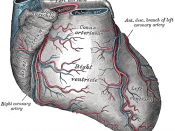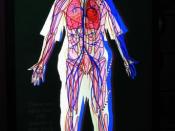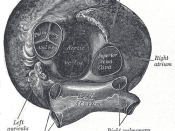Factual essay about the circulatory system Very good
The Circulatory System
The circulatory system in anatomy and physiology is the course taken by the blood through the arteries, capillaries, and veins and back to the heart. In humans and the higher vertebrates, the heart is made up of four chambers the right and left auricles, or atria, and the right and left ventricles. The right side of the heart pumps oxygen-poor blood from the cells of the body back to the lungs for new oxygen; the left side of the heart receives blood rich in oxygen from the lungs and pumps it through the arteries to the various parts of the body. Circulation begins early in fetal life. It is estimated that a given portion of the blood completes its course of circulation in approximately 30 seconds.
Pulmonary circulation is where the blood from the entire body is transported to the right auricle through two large veins.
The superior vena cava and the inferior vena cava. When the right auricle contracts, it forces the blood through an opening into the right ventricle. Contraction of this ventricle drives the blood to the lungs. Blood is prevented from returning into the auricle by the tricuspid valve, which completely closes during contraction of the ventricle. In its passage through the lungs, the blood is oxygenated, that is, then it is brought back to the heart by the four pulmonary veins, which enter the left auricle. When this chamber contracts, blood is forced into the left ventricle and then by ventricular contraction into the aorta. The bicuspid, or mitral, valve prevents the blood from flowing back into the auricle, and the semilunar valves at the beginning of the aorta stop it from flowing back into the ventricle. Similar valves are present in the pulmonary...


